www.idosr.org
©IDOSR PUBLICATIONS
International Digital Organization for Scientific Research
IDOSR JOURNAL OF EXPERIMENTAL SCIENCES 9(1) 72-83, 2023. Modeling and
Mugarura and Guntredi
ISSN: 2579-0781
Simulation of Hybrid Solar-Wind Energy System Using MPPT Algorithm
Mugarura, Ambrose and Guntredi, Venkataramana
School of Engineering and Applied Sciences, Kampala International University Uganda. Ambrose.mugarura@kiu.ac.ug, gvramana@kiu.ac.ug
ABSTRACT
The contemplated hybrid system enables maximum utilization of freely existing renewable energy sources that’s solar and wind energy sources. This system introduces power control strategies of a grid connected solar-wind power generation systems with a versatile power transfer. In this, an adaptive Maximum Power Transfer Tracking algorithm besides the standard perturbs and observations are employed. The system allows usage of two supply sources where loads can be separately supplied or simultaneously supplied depending on the handiness of energy sources. The most determining parameters of mechanical output from wind energy source and the solar energy sources are the turbine rotor speed and the photovoltaic cell operating voltage respectively. Coupled with a wind turbine is a PSMG for theattainabilityofaconversionsystemforwindenergyandaninverterforconvertingdirect current output from a non-conventional energy into the purposeful alternating current. The solar windenergysystems operate undernormal conditions thatinvolve normal windspeed for the case of wind energy and normal room temperature for photovoltaic energy sources.
Key words: MPPT, Photovoltaic, Wind, Power control, PSMG
INTRODUCTION
Electric power systems are amongst the capital investment components of a contemporary economy [1, 2, 3, 4, 5]. Electric power systems involve four main parts which includes Power Generation, Power Transmission, Voltage Transformation and Power Consumption [1, 6, 7, 8] Its normally difficult to construct transmission lines and transformation systems in most remote areas due to their nature [9, 10]. Also, many are looking at sustainable energy alternatives in awake to protect the planet forfuturegenerationsasworryoverglobal warming and the depletion of fossil fuel supplies grows [11, 12]. Above all photovoltaic, wind, and hydro power have the greatestpotentialtosatisfyourenergy needs. Even while wind energy is capable of producing vast amounts of power, it is incredibly unpredictable and may appear oneinstantanddisappearthenext[13,14]
Similartothis,solarenergyisthereallday long, but the amount of solar irradiation varies due to the strength of the sunlight and the unpredictability of the shadows cast by clouds, animals, and other objects
[15]. Both wind and photovoltaic systems have the inherent flaw of being intermittent,whichrendersthemunstable. Thesystem'spowertransferefficiencyand dependability can be considerably increased by merging these two sporadic sources and using maximum power point tracking(MPPT)algorithms [7,8,9].Oneof the most recent developments in power electronics is the merging of renewable energysourcesandenergystoragedevices [2]. In order to maintain or increase the reliabilityandqualityofthepowersupply, new operational strategies for distributed generators and renewable energy sources are needed. Since integrated monitoring and control and consistency in controller structure are more convenient than a common ac type, combining multiple renewable resources via a common dc bus of a power converter has become typical [10,11,12]. Analysis is done on the dynamic performance of a wind and solar system. A model of a wind turbine system was created and contrasted with an actual system. The majority of applications are for standalone operation, with load
www.idosr.org
balancing as the primary control goal. A few grid-connected systems show the grid asmerelya backupoptionto use when the supply from renewable sources is insufficient. They were initially intended to support local load requirements with a chance of a temporary loss of power supply. However, a hybrid system that injects electricity more steadily or has the ability to regulate its power flexibly is preferable from the standpoint of utility. Users also like a system that offers a varietyofpowertransferalternativessince it improves system management and functioning [3] Such a hybrid system's control techniques ought to be very dissimilar from those of conventional systems. In this paper, a grid-connected wind-Solar-battery hybrid system with flexible power transfer is dynamically modeled and controlled. In contrast to conventional systems, the hybrid system takes into account the grid's ability to dispatch its power injection. The hybrid system has three operating modes:
Mugarura and Guntredi
dispatch operation, averaging operation, and normal operation without battery utilization [2].
Two modified techniques that is a modifiedhysteresiscontrolapproachfora battery charger/discharger and a power averaging technique utilizing a low-pass filter are used to successfully accomplish such modes of operation. The hybrid system's idea, operation, and supervisory control are described. In the control of wind turbines and PV arrays, conventional maximum power tracking techniques are used. Power System Computer Aided Design/Electromagnetic Transients Program for DC (PSCAD/EMTDC), powersystem transient-analysis software,served as the foundation for dynamic modeling and simulations. The program was built using Dommel's method, which was created especially for simulating highvoltage direct current systems and is effective for simulating transients in power systems that are controlled by power electronics [4].

Problem Statement
Due to several differences of Solar-Wind resources in different places, the solarwindhybridsystemdesignshouldbase on the special location situation.
Purpose of the study
TomodelandsimulateahybridSolar-Wind Energy System Using Maximum Power Point Tracking Algorithm
Specific Objectives
To design different schemes of a Hybrid System (Solar and Wind Energy)
To simulate the optimized schemes of Hybrid Energy systems to analyse the power supply quality
To increase the efficiency of the System Research Questions
How to design different alternative schemes of the hybrid energy system?
What are the optimized techniques of the hybrid energy system & which is the best technique?
How to improve efficiency of the system?
www.idosr.org
Scope of the study
This hybrid system is modelled for 30MW Nakasongola Military Barracks Solar power plant in Central Uganda
Significance of the study
In a hybrid energy system, wind and solar power proportions impact the reliability andeconomyofthesystemsincesolarand wind resources vary from an area to another. It is very crucial to optimize and
Mugarura and Guntredi
simulate the system in order to construct a solar wind hybrid system that can steadily supply power and cost effective [6].
This study will help the government and investors realize the feasibility, power supply quality, Capital cost and operational cost of the hybrid system in Uganda that will help them in decision making towards investment plans.
METHODOLOGY Simulation
SimulationisaccomplishedbySimulinkan environmentwithmultidomainsimulation and its model-based design for embedded systems. Simulink provides a graphical interface and also has customized set of
block libraries which help in designing, simulating, implementing and testing various systems which vary with time like videoprocessing,imageprocessing,signal processing and in communication controls.

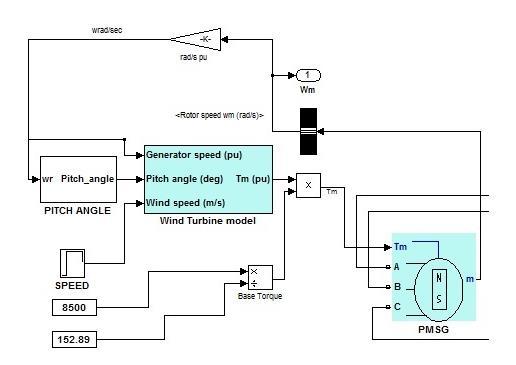
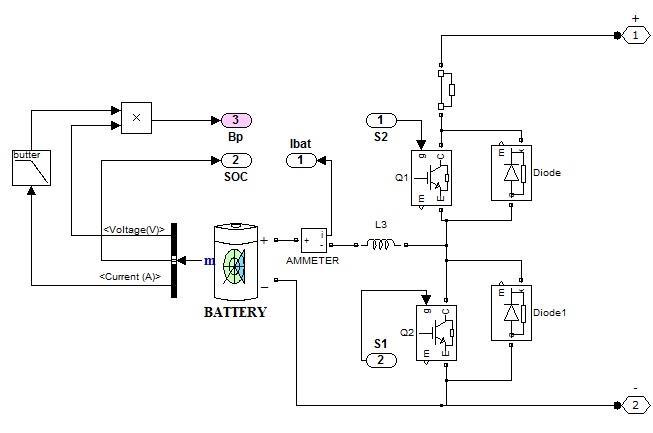
RESULTS ANALYSIS AND DISCUSSION
Simulink software gives displays and scopes which help in visualizing the system. Results can also be analysed by

building customizable displays using MATLAB visualization and GUI development tools.
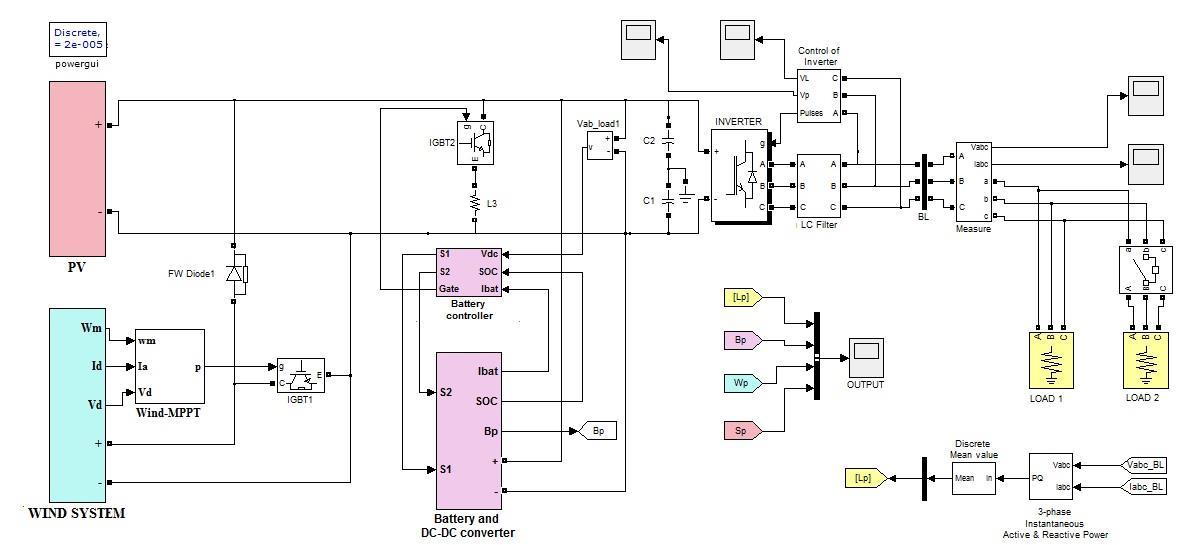
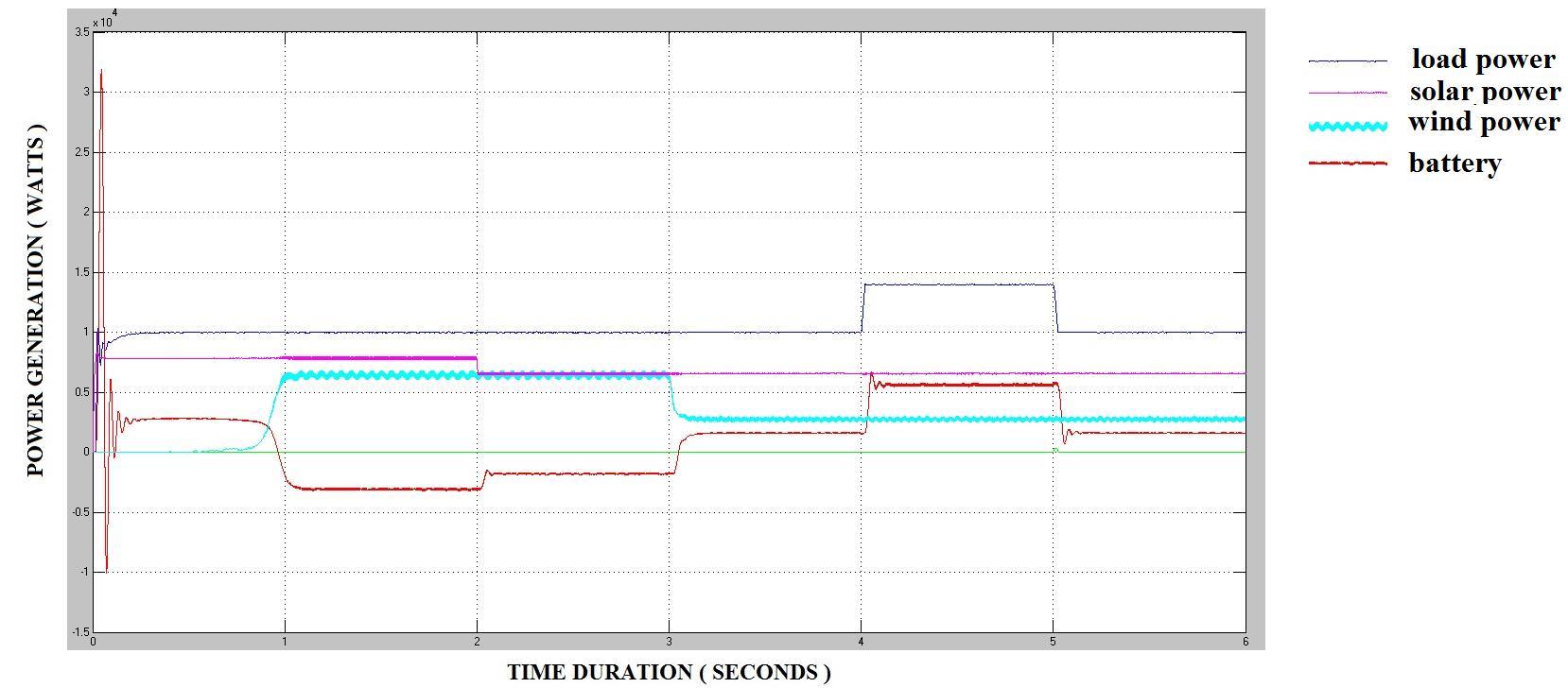




Time(S) Characteristics
0-1 Photovoltaic energy at full irradiance
Batteries partially supply for the load
Wind Turbines tend towards base speed of 12m/s after a period of 0.5 seconds
Load is at 10kW
1-2 Wind achieves 5.6kW
Batteries store 5Kw
2-3 Photovoltaic energy reduced by 15%
Batteries store 3.5Kw
3-4 Speed of the wind reduces to 9m/s
Batteries partially supply for the load
4-5 Load increased by 40% Batteries are responsible for increased load demand
5-6 Load demand settles to the previous point
Yielded values for the photovoltaic panel
Open Circuit Voltage (������) = 36.60V
Max. Power Current(������) = 30.3V
Short Circuit Current (������) = 8.01A
Number of cells in a ROW = 11
Number of cells in (2*1) = photovoltaic
Array = 11*2=22 Cells
% Error in accomplishing Max. Power point
Tracker = 4%
Max. Power point Tracker Voltage = 666
(666∗ 04)=640
The preferred Direct Current link =640
Max. Power from a single Photovoltaic ������ *������ =30.3*7.10=215.13W
Max. Power from a single ROW =11*215.13 = 2366.43W = 2.4kW
Max. Power delivered by a single solar module = (2366.43V+2366.43) =4732.86W =4.7kW
Total Power from the two modules = 4732.86*2 = 9465.7W=9.5kW
Max. Irradiance = 1000
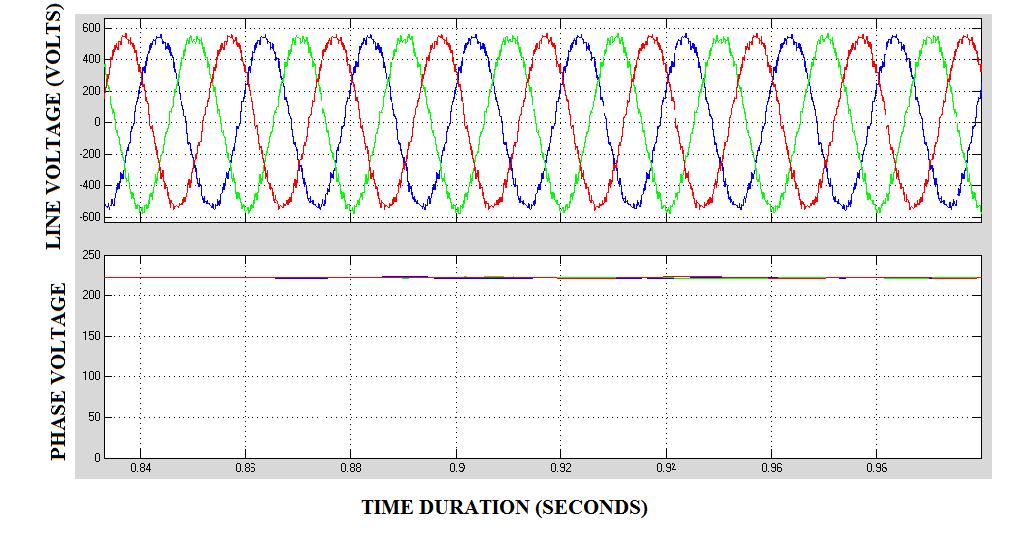
www.idosr.org
Max. Power at Max. Irradiance =9.5kW
After 2 seconds, % irradiance reduced by 15% to 85%.
Solar power cut down = 9.5-(9.5*0.15) = 8.1Kw
Yielded Values from wind Energy System
�� = 120�� ��
Where;
N= Revolutions per minute (rpm)
P= Number of poles = 4 Poles
f= Output frequency of Permanent Synchronous Generator (PMSG)
�� = 120∗50 4 = 1500 rpm
Converting 1500rpm into radians per second
1500Rpm= 1500*2Ω/60 = 157 rad/s
Nominal Mech. Output Power of the wind turbine = 8.5kW
Power = ����
Where;
��= Base torque
��=Angular Velocity
��������������������(��)
=8500/157=54.15J
Mugarura and Guntredi
Working Performance of various photovoltaic panels is represented through simulated results. Differences in the output are to altered current and voltage ratings. Delivered current and Voltage ratings depend on the physical conditions prevailing in its surroundings and on its physical characteristics.
Simulated Graphs
Photovoltaicenergydropsitsirradianceby 15% from 2 seconds.
10kW is the load demanded to fulfil throughout the time frame except at 4 to 5 seconds when it increases to 14kW.
Initially wind turbines rotating at 5m/s except to the base speed of 12m/s after 0.5s where its rotating reduced by 25% of its base speed.
From the graph below, all the above characteristics are clearly observed. The Photovoltaic Array’s Maximum voltage is around 640V. The deciding factor of the maximum voltage is explained by the varying irradiance as shown by the following curve.
3: Major Landmarks of Proposed Hybrid System
CONCLUSION
In this thesis an inverter was used for converting solar systems and wind systems output into alternating current power output. The load demand was met bythecombinationofwindenergysystem, PhotovoltaicenergysystemsandBatteries. The circuit breakers were used for providing a connection to an additional load of 5kW in a stipulated period of time.
In order to provide maximum output power to meet load demand under all operating conditions, the hybrid was controlled. Both the simultaneous operation of wind and solar systems, singlyoperationofwindsystemandsingly operation photovoltaic system were supported by the battery
RECOMMENDATIONS
In order to dispose excess power, dump loads can be used optimum modelling of essential parameters can be applied to control the losses incurred in the initial stages of operation of wind turbines
Mugarura and Guntredi
Other Different methods of Maximum Power Point Trackers can be implemented andcompared.Todistributethegenerated power, distribution transformers can be added to system.
REFERENCES
[1]. Daconti, J. R. and Lawry, D. C. (2003). Increasing Power Transfer Capability of Existing Transmission Lines, in Proceedings of the IEEE PowerEngineering Society Transmission and Distribution Conference, vol. 3. doi: 10.1109/tdc.2003.1335079.
[2]. Jain, S. and Agarwal, V. (2008). An integrated hybrid power supply for distributedgenerationapplications fedby nonconventional energy sources, IEEE Trans. Energy Convers., vol.23,no. 2.doi: 10.1109/TEC.2008.918631.
[3]. Hui, J. C. Y., Bakhshai, A. and Jain, P. K. (2016). An Energy Management Scheme with Power Limit Capability and an Adaptive Maximum Power Point Tracking for Small Standalone PMSG Wind Energy Systems, IEEE Trans. Power Electron., vol. 31,no. 7.doi:10.1109/TPEL.2015.2478402.
[4]. Muzzammel, R., Khail, I., Tariq, M. H., Asghar, A. M. and Hassan, A. (2019). Design and Power Flow Analysis of Electrical System Using Electrical Transient and Program Software, Energy Power Eng., vol. 11, no. 04. doi: 10.4236/epe.2019.114011.
[5]. Rehman, S., Habib, H. U. R., Wang, S., Buker,M.S.,Alhems,L.M.andAlGarni,H. Z. (2020). Optimal Design and Model Predictive Control of Standalone HRES: A Real Case Study for Residential Demand Side Management, IEEE Access, vol. 8 doi: 10.1109/ACCESS.2020.2972302.
[6]. Sawle, Y., Jain, S., Babu, S., Nair, A. R. and Khan, B. (2021). Prefeasibility Economic and Sensitivity Assessment of Hybrid Renewable Energy System IEEE Access, vol. 9, 2021, doi: 10.1109/ACCESS.2021.3058517.
[7]. Abdulfatah A Yusuf, Hadijah Yahyah, AtikuAFarooq,KasumbaABuyondo,Peter W Olupot, Sharif S Nura, Tajuddeen Sanni, Twinomuhwezi Hannington, Zubeda Ukundimana, Abdurrahman S Hassan, Mustafa M Mundu, Sibuso S Samede, Yakubu A Makeri, Milon D Selvam (2021)
Characteristics of ultrafine particle emission from light-vehicle engine at city transport-speed using after-treatment device fueled with n-butanol-hydrogen blend. Case Studies in Chemical and Environmental Engineering 3-100085
[8]. Jean-RostandFK,MMMustapha,IAdabara, AS Hassan (2019) Design of an automatic transfer switch for households solar PV system European Journal of Advances in Engineering and Technology 6 (2), 54-65
[9]. NnamchiS N ,MMMundu,JDBusingye,JU Ezenwankwo (2019) Extrinsic modeling and simulation of helio-photovoltaic system: a case of single diode model. International journal of green energy 16 (6), 450-467.
[10]. Muhamad Mustafa Mundu, Stephen Ndubuisi Nnamchi, Kelechi John Ukagwu, Benjamin Aina Peter, Onyinyechi Adanma
Nnamchi, Jotham Ivan Ssempewo (2019) . Numerical modelling of wind flow for solar power generation in a case study of thetropicalzones. ModelingEarth Systems and Environment,8 (3): 4123-4134.
[11]. Stephen Ndubuisi Nnamchi, Muhamad
Mustafa Mundu, Onyinyechi Adanma
Nnamchi, Uche Onochie, Zaid Oluwadurotimi Jagun (2022) Differential modelling and simulation of solar power potential: a helio-application of biharmonic model Modeling Earth Systems and Environment,8(2):2383-2400
[12]. Stephen Ndubuisi Nnamchi, Onyinyechi Adanma Nnamchi, Oluwatosin Dorcas
Sanya, Mustafa Muhamad Mundu, Vincent Gabriel (2020). Dynamic analysis of performance of photovoltaic generators undermovingcloudconditions. Journal of Solar Energy Research, 5(2): 453-468.
[13]. Muhamad Mustafa Mundu, Stephen Ndubuisi Nnamchi, Onyinyechi Adanma
Nnamchi (2021) Development of a model for estimation of sunshine hour data for
www.idosr.org
different regions of Uganda. Journal of Renewable Energy and Environment 8(1): 69-76.
[14]. Stephen Ndubuisi Nnamchi, Mustafa Muhamad Mundu (2022) Development of solar isodose lines: Mercatorian and spatial guides for mapping solar installation areas Heliyon8 (10) e11045
[15]. BenjaminAinaPeter,AmosWaleOgunsola, AnthonyEjehItodo,IdowuSabikiAdebola,
Mugarura and Guntredi
MunduMuhamadMustapha(2019).ANonIsothermal Reacting MHD Flow over a Stretching Sheet Through a Saturated Porous Medium American Journal of Mathematical andComputational Sciences
4(1): 1-10
